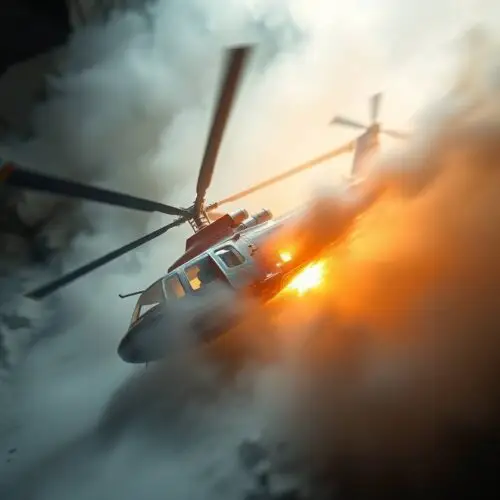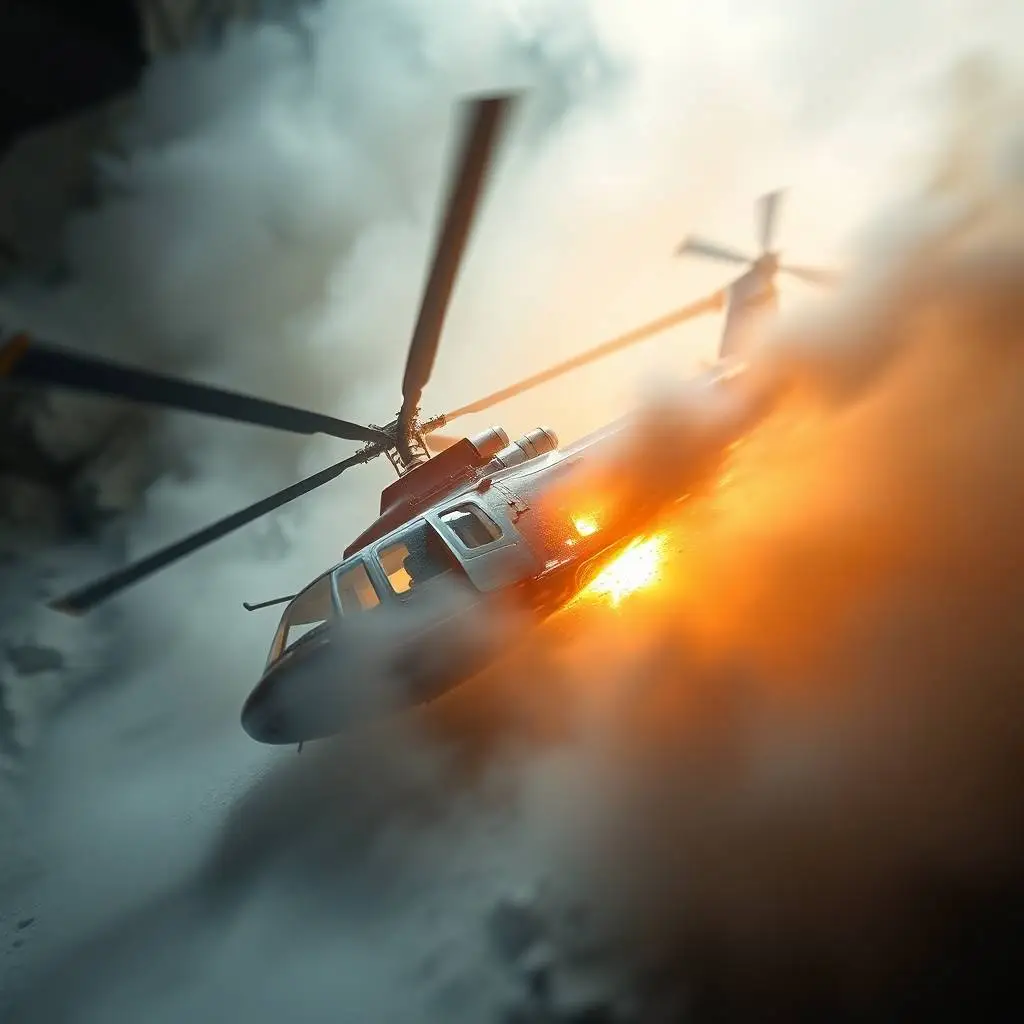
Kedarnath Helicopter Crash: What Happened?
Kedarnath Helicopter Crash casts a somber shadow over Uttarakhand’s revered Char Dham Yatra, as a tragic incident on June 15, 2025, claimed the lives of seven individuals, including five pilgrims, a pilot, and an employee of the Badrinath-Kedarnath Temple Committee. The Aryan Aviation Bell 407 helicopter, en route from Kedarnath to Guptkashi, crashed near Gaurikund in Rudraprayag district at approximately 5:20 AM, reportedly due to poor visibility caused by dense fog and adverse weather conditions. This devastating event, the fifth helicopter-related mishap on the Char Dham route since May 2, 2025, has prompted the Uttarakhand government to suspend helicopter services for two days and sparked a broader conversation about the safety of aerial operations in the region’s challenging terrain. As investigations unfold, questions linger about what could have been done to prevent this tragedy and how to ensure the safety of countless pilgrims who rely on these services annually.
The ill-fated helicopter, operated by Aryan Aviation, took off from the Kedarnath helipad at 5:19 AM after a brief stop, carrying six passengers, including a 23-month-old infant, and the pilot, Rajveer Singh Chauhan, a retired Lieutenant Colonel with over 15 years of experience in the Indian Army. Mere minutes after takeoff, the aircraft crashed into a forested area between Gaurikund and Sonprayag, reportedly catching fire upon impact. The remote location of the crash site complicated rescue efforts, with National Disaster Response Force (NDRF) and State Disaster Response Force (SDRF) teams rushing to the scene. Tragically, all seven individuals on board perished, including a Maharashtra couple and their young daughter, whose son survived as he had stayed behind.
This incident marks the second crash involving Aryan Aviation in recent weeks, raising serious questions about the operator’s safety protocols. The Directorate General of Civil Aviation (DGCA) has launched an investigation through the Aircraft Accident Investigation Bureau to determine the precise cause, with preliminary reports pointing to zero visibility due to inclement weather as a key factor.
A Troubling Pattern of Incidents
The Kedarnath Helicopter Crash is not an isolated event. Since the Char Dham Yatra began on April 30, 2025, five helicopter-related incidents have been reported in Uttarakhand, resulting in 13 deaths. On May 8, a helicopter en route to Gangotri Dham crashed in Uttarkashi, killing six people. On May 12, a chopper returning from Badrinath made an emergency landing due to poor visibility, with no casualties. On May 17, a heli-ambulance crash-landed near the Kedarnath helipad, again without fatalities. Most recently, on June 7, a Kestrel Aviation helicopter made an emergency landing on a highway due to a technical fault, with all passengers safe thanks to the heroic efforts of a local woman named Laxmi, who rescued three pilgrims.
This alarming frequency of incidents has raised eyebrows and intensified scrutiny of helicopter operations in the region. The rugged Himalayan terrain, combined with unpredictable weather, poses unique challenges for aviation, yet the reliance on helicopters to ferry pilgrims to remote shrines like Kedarnath remains critical. Could these tragedies have been avoided with stricter regulations or better technology? The recurring nature of these incidents begs for answers.
Why Do These Crashes Keep Happening?
The Kedarnath Helicopter Crash underscores the inherent risks of operating in Uttarakhand’s high-altitude, weather-prone environment. Experts point to several factors that may contribute to such incidents:
- Adverse Weather Conditions: Dense fog, sudden storms, and low visibility are common in the Himalayan region, particularly during early morning flights when many pilgrimages begin. The June 15 crash was attributed to zero visibility, a recurring issue in previous incidents.
- Technical Challenges: Helicopters operating in high-altitude areas face unique mechanical stresses. The June 7 Kestrel Aviation incident was linked to a technical fault in the collective control, while earlier crashes involved rotor issues.
- Operational Oversight: The DGCA has noted violations of standard operating procedures (SOPs) by some operators, including improper helicopter parking and inadequate safety checks. Following the June 7 incident, two operators, including Kestrel Aviation, faced temporary suspensions for SOP violations.
- High Demand and Overloading: The Char Dham Yatra attracts thousands of pilgrims, putting pressure on operators to maximize flights. Concerns about overloading and rushed schedules have surfaced, with some suggesting these factors compromise safety.
These elements, combined with the region’s unforgiving geography, create a perfect storm for aviation risks. The question remains: how can authorities balance the spiritual aspirations of pilgrims with the imperative of safety?
The Human Cost of the Tragedy
The Kedarnath Helicopter Crash is not just a statistic—it’s a heartrending loss of lives, each with a story. Among the victims was Rajveer Singh Chauhan, the pilot, who had recently become a father to twins. His 15 years of military experience and expertise in navigating challenging terrains made his loss particularly poignant. A Maharashtra family, including Rajkumar and Shraddha Jaiswal and their 23-month-old daughter, perished, leaving behind their surviving son, who had stayed back. An employee of the Badrinath-Kedarnath Temple Committee was also among the deceased, highlighting the diverse group of individuals affected by this tragedy.
Uttarakhand Chief Minister Pushkar Singh Dhami expressed deep sorrow, describing the incident as “extremely sad” and announcing a two-day suspension of helicopter services to ensure passenger safety. The outpouring of grief from the community and across social media reflects the profound impact of this loss, with many questioning how such incidents continue to occur despite advancements in aviation technology.
What’s Being Done to Address the Crisis?
In response to the Kedarnath Helicopter Crash, swift actions have been taken to address immediate safety concerns and prevent future tragedies:
- Suspension of Services: CM Dhami announced a two-day halt to helicopter operations in the region, emphasizing that services will remain suspended until passenger safety is assured.
- DGCA Investigation: The Aircraft Accident Investigation Bureau is probing the crash, with a focus on weather conditions, mechanical failures, and operator compliance with safety protocols. The DGCA has also reduced the frequency of Char Dham helicopter operations and is conducting enhanced surveillance.
- Calls for Reform: Experts and Char Dham Yatra organizers have demanded a high-level technical audit of all helicopter operators and stricter adherence to SOPs. Some have called for a complete overhaul of aviation regulations for pilgrimage routes.
- Community Support: Local heroes like Laxmi, who risked her life to save passengers in the June 7 incident, highlight the importance of community preparedness and rapid response in such crises.
These measures signal a commitment to addressing the crisis, but they also raise a critical question: are temporary suspensions and investigations enough to address systemic issues in high-risk aviation zones?
A Call for Reflection and Action
The Kedarnath Helicopter Crash is a stark reminder of the delicate balance between faith, accessibility, and safety. The Char Dham Yatra is a deeply spiritual journey for millions, and helicopters play a vital role in making sacred sites like Kedarnath accessible to those who cannot undertake the arduous trek. Yet, the recurring accidents demand a reevaluation of how these services are managed.
Could advanced weather forecasting systems reduce the risks of flying in fog-prone areas? Should operators face stricter licensing requirements? Are pilgrims being adequately informed of the risks involved? These are questions that linger in the wake of this tragedy, urging authorities, operators, and the public to reflect on the path forward.
As the investigation into the Kedarnath Helicopter Crash continues, the focus must remain on preventing future losses. The memory of those lost—pilgrims seeking divine blessings, a dedicated pilot, and a temple committee employee—calls for meaningful change. The Char Dham Yatra is a journey of faith, but it must also be a journey of safety.
How Can We Ensure Safer Skies?
The Kedarnath Helicopter Crash has sparked a broader conversation about aviation safety in challenging environments. Stakeholders must consider long-term solutions, such as:
- Enhanced Weather Monitoring: Investing in real-time weather tracking systems to provide pilots with accurate data.
- Stricter Regulations: Enforcing rigorous maintenance checks and limiting flight schedules during high-risk weather periods.
- Pilot Training: Specialized training for navigating high-altitude, weather-prone regions.
- Public Awareness: Educating pilgrims about the risks of helicopter travel and ensuring transparent communication from operators.
The tragedy has also highlighted the resilience of communities, with locals and rescue teams stepping up in times of crisis. Their efforts remind us that while technology and regulations are critical, human courage and compassion are equally vital in the face of adversity.
Looking Ahead: A Safer Pilgrimage
The Kedarnath Helicopter Crash is a painful chapter in the history of the Char Dham Yatra, but it also presents an opportunity for change. As Uttarakhand mourns the loss of seven lives, the collective resolve to improve aviation safety grows stronger. The DGCA’s investigation, coupled with the government’s commitment to stricter oversight, offers hope that future pilgrims can undertake their spiritual journeys without fear.
What will it take to restore confidence in helicopter services to Kedarnath and other sacred sites? The answer lies in a collaborative effort between regulators, operators, and the public to prioritize safety above all else. As the nation reflects on this tragedy, one thing is clear: the skies above Kedarnath must become a place of hope, not heartbreak.















